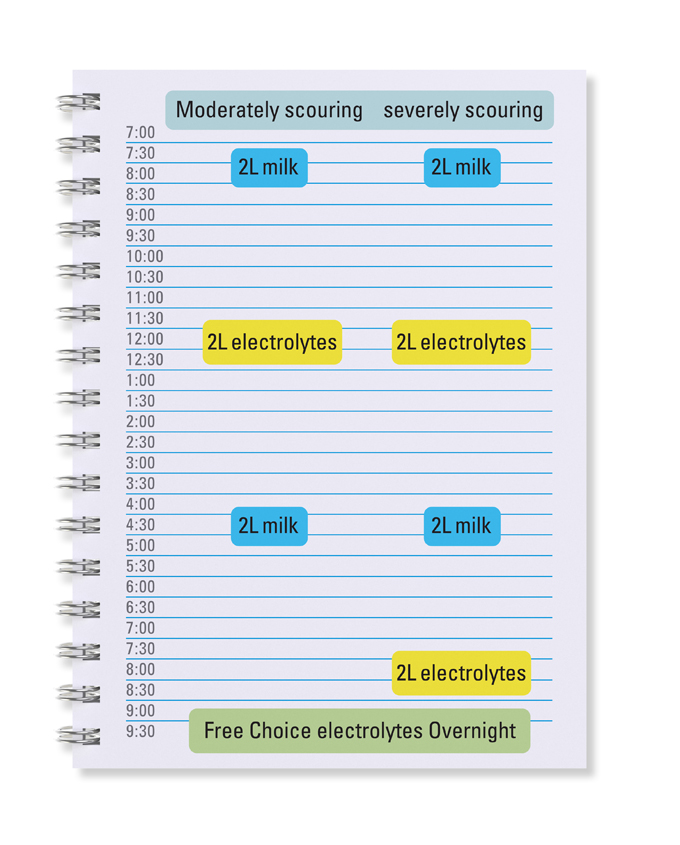IDENTIFY AND TREAT SCOURS > VIDEO
Knowing what to do at the first sign of calf scours will save you stress this season.

IDENTIFY AND TREAT SCOURS > FACT-SHEET
Calf Scours on the farm
A calf gets scours when it accidentally eats more scours-causing germs than its immune system can handle. This happens if:
- Its food/environment contains too many scours-causing germs (hygiene) AND/OR
- Its immune system isn’t working as well as it could be (colostrum management)
Despite your best efforts to prevent it, you may still get scours cases.
Monitoring Calf Scours
Monitor your calf treatments in a book in the calf shed, and get your vet out ASAP if you:
- Are treating more than 1 out of 10 calves with electrolytes or medicines*
- Have more than 1 out of 30 calves die before weaning* or if you
- Have a spike in the number of scours cases or deaths
Symptoms to identify calf scours
- Reduced appetite
- Lagging behind
- Standing hunched up
- Drooping ears/sunken eyes
- Dirty backside/tail
- Liquid or bloody faeces
Nutritional scours possible if:
- Many calves have loose faeces
- Recent change of diet
- All still bright
** Ring vet if unsure whether scours is nutritional or infectious
Isolate and treat scouring calves as soon as possible.
Act immediately if they show any of these signs of dehydration:
- Sunken eyes
- Weak suckle reflex
- Skin stays lifted when you pinch
Treating Calf Scours
If you’re having a scours problem:
- Get your vet involved ASAP
- Check hygiene and colostrum management practices
- Take samples if vet can’t come out straight away
- As many fresh faecal samples as possible
- From calves which have started scouring within the last 24 hours
- Put into clean plastic pottle or glove
- Label with calf or pen ID
- Take samples to vet clinic ASAP
- Alternate milk and electrolyte feeds to scouring calves
- Nipple feed or tube 6-8L of total fluids each day
- Tube calves with electrolytes if they won’t drink

- If calf can’t suckle or stand, have vet treat with IV fluids or humanely euthanase immediately
- Use a commercial electrolyte — follow label instructions
- Provide additional free choice water and electrolytes
- Treat calves with any necessary antibiotics or anti-inflammatory drugs prescribed by your vet — double check dosages and treatment schedule
REFERENCES
- Berge, ACB et al. (2009). Evaluation of the effects of oral colostrum supplementation during the first fourteen days on the health and performance of pre-weaned calves. Journal of Dairy Science. 92:286–95
- Chuck, G. (2015). Calfwise: right from the start. 2015 Proceedings of the Society of Dairy Cattle Veterinarians of the NZVA Annual Conference. p71-80.
- Chuck, G. (2015). Targeting calf-hood morbidity & mortality. 2015 Proceedings of the Society of Dairy Cattle Veterinarians of he NZVA Annual Conference. p227-232.
- Conneely, M. et al. (2013). Factors associated with the concentration of immunoglobulin G in the colostrum of dairy cows. Animal 7:11. p1824-1832. https://www.cambridge.org/core/journals/animal/
- Cuttance, E. & Denholm, K. (2016). Dairy NZ technical series. Colostrum management: giving calves a great start to life. Accessed online: www.dairynz.co.nz/media/4439069/tech-series-june-2016-colostrum-management.pdf
- Denholm, K et al. (2017). Associations between management practices and colostrum quality on New Zealand dairy farms. New Zealand Veterinary Journal. 65:5. p257-263. DOI: 10.1080/00480169.2017.1342575
- Faber, SN et al. (2005). Case study: effects of colostrum ingestion on lactational performance. The Professional Animal Scientist. 21:420-425.
- Godden, SM et al. (2012). Heat treated colostrum and reduced morbidity in preweaned dairy calves: Results of a randomised trial and examination of mechanisms of effectiveness. Journal of Dairy Science. 95: 4029-4040.
- Gomes, V. et al. (2011). Factors affecting immunoglobulin concentration in colostrum of healthy holstein cows immediately after delivery. Pesq. Vet. Bras. 31:1. http://dx.doi.org/10.1590/S0100-736X2011001300009
- Morrison, S. (2013). The impact of calf health on future performance. Veterinary Ireland Journal. 3:264–8.
- Parkinson, TJ et al. (2010). Calves: management & disease. Diseases of cattle in Australasia: a comprehensive textbook. VetLearn. pp.627-659.
- Recca, A. et al. (2003). Comparative lactogenic antibody responses of cattle from European field trials with a new enteric disease vaccine. Vet Record. 152: 751-752.
- Schouten, B, et al. (2005). Oral electrolytes? A comparative study of some commercial electrolytes. NZVA VetScript.18:6. pp 35-39.
FOR MORE:
Or find us on YouTube by searching: TopFarmersNZ
Or visit: msd-animal-health.co.nz

Top Farmers Know-How provides a reference library of industry best practice in some key animal health management areas including mastitis, dry off, calf health, BVD, salmonella and campylobacter. We know that farmers and vets are busy people, so we’ve created resources in different formats and in bite-sized chunks to make it more flexible and accessible.
